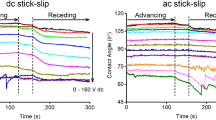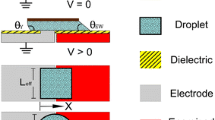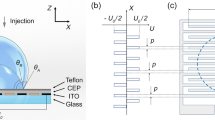Abstract
An accurate description of contact angle hysteresis in AC electrowetting is important for a wide range of practical electrowetting applications. This work demonstrates that electrowetting actuated advancing contact angles and the reduction of contact angle hysteresis in AC electrowetting are better predicted when characterizing the advancing electrowetting force by its root mean square (rms) value as opposed to its time-averaged or maximum values. Characterizing the electrowetting force by its rms value allows the transient electrowetting force to exceed the pinning force for some amount of time overcoming the inertial effects at the contact line before advancement. This is opposed to the maximum force characterization which implies that inertial effects can be neglected at the contact line resulting in immediate advancement when the forces are unbalanced.






Similar content being viewed by others
Data availability statement
The datasets generated during and/or analyzed during the current study are available from the corresponding author on reasonable request.
Abbreviations
- \(a\) :
-
Subscript denoting a property when the contact line is advancing
- \({\text{avg}}\) :
-
The time-averaged value of a transient variable. Superscript/subscript denoting the time-averaged value
- \(c\) :
-
Capacitance per unit area of the solid–liquid interface on an electrowetting on dielectric device
- \({\text{crit}}\) :
-
Subscript denoting a property associated with the critical Electrowetting number where contact angle hysteresis is predicted to be eliminated
- Ew:
-
Electrowetting number, a ratio of electrical and interfacial energy at the solid–liquid interface and subscript denoting a property under that electrowetting number. Superscript and subscript denoting properties (e.g., contact angle) under electrowetting actuation
- \(f^{\prime}\) :
-
Force per unit length at the contact line (in the units of surface tension)
- \(f\) :
-
Dimensionless force at the contact line
- \({\text{int}}\) :
-
Superscript denoting the case where the electrowetting number is such that the cosine of the advancing and receding contact angles both intersect with the electrowetting equation
- \({\text{LM}}\) :
-
Subscript denoting a property associated with the interface between the liquid droplet and surrounding medium
- \({\text{max}}\) :
-
The maximum value of a transient variable. Superscript/subscript denoting the maximum value
- \({\text{min}}\) :
-
The minimum value of a transient variable. Superscript/subscript denoting the minimum value
- \(p\) :
-
Subscript denoting pinning force
- \(pk\) :
-
Superscript denoting peak voltage
- \(r\) :
-
Subscript denoting a property when the contact line is receding
- \({\text{rms}}\) :
-
Subscript denoting the root mean square average of a transient variable
- \({\text{SL}}\) :
-
Subscript denoting a property associated with the interface between the solid and the liquid droplet
- \({\text{SM}}\) :
-
Subscript denoting a property associated with the interface between the solid and the surrounding medium
- \(t\) :
-
Time
- \(U\) :
-
Voltage
- \(Y\) :
-
Superscript denoting the equilibrium contact angle suggested by Young’s equation
- \(\alpha\) :
-
Constant found to scale dimensionless pinning force to electrowetting number for pinning forces under various contact line pinning models
- \(\gamma\) :
-
Surface tension between any two phases in the system
- \(\theta\) :
-
Contact angle
- \(\omega\) :
-
Actuation frequency of an electrical voltage
- \(0\) :
-
Subscript denoting the unactuated condition (i.e., \(Ew = 0\))
References
Bernetski KA, Burkhart CT, Maki KL, Schertzer MJ (2018) Characterization of electrowetting, contact angle hysteresis, and adhesion on digital microfluidic devices with inkjet-printed electrodes. Microfluid Nanofluid 22(96):1–10. https://doi.org/10.1007/s10404-018-2119-4
Bernetski KA, Maki KL, Schertzer MJ (2019) Comment on “how to make sticky surfaces slippery: contact angle hysteresis in electrowetting with alternating voltage”. Appl Phys Lett 114: 116101–116102. https://doi.org/10.1063/1.5087712
Burkhart CT, Maki KL, Schertzer MJ (2020) Coplanar electrowetting-induced droplet detachment from radially symmetric electrodes. Langmuir 36(28):8129–8136. https://doi.org/10.1021/acs.langmuir.0c01015
Cho SK, Moon H, Kim C-JJ (2003) Creating, transporting, cutting, and merging liquid droplets by electrowetting-based actuation for digital microfluidic circuits. J Microelectromech Syst 12(1):70–80. https://doi.org/10.1109/JMEMS.2002.807467
Choi K, Ng AHC, Fobel R, Wheeler AR (2012) Digital microfluidics. Annu Rev Anal Chem (Palo Alto, Calif.) 5: 413–440. https://doi.org/10.1146/annurev-anchem-062011-143028
Eral HB, Augustine DM, Duits MHG, Mugele F (2011) Suppressing the coffee stain effect: how to control colloidal self-assembly in evaporating drops using electrowetting. Soft Matter 7(10):4954. https://doi.org/10.1039/c1sm05183k
Klarman D, Andelman D, Urbakh M (2011) A model of electrowetting, reversed electrowetting, and contact angle saturation. Langmuir 27(10):6031–6041. https://doi.org/10.1021/la2004326
Li J, Kim CJ (2020) Current commercialization status of electrowetting-on-dielectric (EWOD) digital microfluidics. Lab Chip 20(10):1705–1712. https://doi.org/10.1039/d0lc00144a
Li F, Mugele F (2008) How to make sticky surfaces slippery: contact angle hysteresis in electrowetting with alternating voltage. Appl Phys Lett 92(24):12–15. https://doi.org/10.1063/1.2945803
Li F, Mugele F (2019) Response to “Comment on ‘how to make sticky surfaces slippery: contact angle hysteresis in electrowetting with alternating voltage’” Appl Phys Lett 114(11):116101–116102. https://doi.org/10.1063/1.5087712
Liu R, Yang YR, Wang XD (2021) Electrowetting-on-dielectric-induced nanodroplet splitting between two parallel plates. Microfluid Nanofluid 25(1):1–12. https://doi.org/10.1007/s10404-020-02409-4
Mampallil D, Eral HB, van den Ende D, Mugele F (2012) Control of evaporating complex fluids through electrowetting. Soft Matter 8(41):10614. https://doi.org/10.1039/c2sm26103k
Markodimitrakis IE, Sema DG, Chamakos NT, Papadopoulos P, Papathanasiou AG (2021) Impact of substrate elasticity on contact angle saturation in electrowetting. Soft Matter 17(16):4335–4341. https://doi.org/10.1039/d0sm02281k
Mugele F (2009) Fundamental challenges in electrowetting: from equilibrium shapes to contact angle saturation and drop dynamics. Soft Matter 5(18):3377. https://doi.org/10.1039/b904493k
Mugele F, Baret J-C (2005) Electrowetting: from basics to applications. J Phys Condens Matter 17(28):R705–R774. https://doi.org/10.1088/0953-8984/17/28/R01
Mugele F, Heikenfeld J (2018) Electrowetting: fundamental principles and practical applications. Wiley
Nelson WC, Kim C-J (2012) Droplet actuation by electrowetting-on-dielectric (EWOD): a review. J Adhes Sci Technol 26(12–17):1747–1771. https://doi.org/10.1163/156856111X599562
Orejon D, Sefiane K, Shanahan MER (2013) Evaporation of nanofluid droplets with applied DC potential. J Colloid Interface Sci 407:29–38. https://doi.org/10.1016/j.jcis.2013.05.079
Paik P, Pamula VK, Pollack MG, Fair RB (2003) Electrowetting-based droplet mixers for microfluidic systems. Lab Chip 3(1):28–33. https://doi.org/10.1039/b210825a
Pollack MG, Fair RB (2000) Electrowetting-based actuation of liquid droplets for microfluidic applications. Appl Phys Lett 77(11):1725–1726
Quinn A, Sedev R, Ralston J (2005) Contact angle saturation in electrowetting. J Phys Chem B 109(13):6268–6275. https://doi.org/10.1021/jp040478f
Reid RC, Merrill MH, Thomas JP (2020) Stick–slip behavior during electrowetting-on-dielectric: polarization and substrate effects. Microfluid Nanofluid 24(10):1–9. https://doi.org/10.1007/s10404-020-02374-y
Samiei E, Luka GS, Najjaran H, Hoorfar M (2016) Integration of biosensors into digital microfluidics: impact of hydrophilic surface of biosensors on droplet manipulation. Biosens Bioelectron 81:480–486. https://doi.org/10.1016/j.bios.2016.03.035
Teng P, Tian D, Fu H, Wang S (2020) Recent progress of electrowetting for droplet manipulation: from wetting to superwetting systems. Mater Chem Front 4(1):140–154. https://doi.org/10.1039/c9qm00458k
’t Mannetje DJCM, Mugele F, van den Ende D (2013) Stick–slip to sliding transition of dynamic contact lines under AC electrowetting. Langmuir 29(48):15116–15121https://doi.org/10.1021/la402761m
Vallet M, Vallade M, Berge B (1999) Limiting phenomena for the spreading of water on polymer films by electrowetting. Eur Phys J B 11(4):583–591. https://doi.org/10.1007/s100510051186
Walker S, Shapiro B (2006) Modeling the fluid dynamics of electrowetting on dielectric (EWOD). J Microelectromech Syst 15(4):986
Wang H, Chen L, Sun L (2017) Digital microfluidics: a promising technique for biochemical applications. Front Mech Eng 12(4):510–525. https://doi.org/10.1007/s11465-017-0460-z
Acknowledgements
We gratefully acknowledge support from ADVANCE RIT (funded through the National Science Foundation under Award No. HRD-1209115) and the Kate Gleason College of Engineering at RIT.
Funding
Partial financial support was received from ADVANCE RIT (funded through the National Science Foundation under Award No. HRD-1209115) and the Kate Gleason College of Engineering at RIT.
Author information
Authors and Affiliations
Corresponding author
Ethics declarations
Conflict of interest
The authors have no relevant financial conflicts of interests to disclose. Dr. Schertzer’s research group received funding from an industrial partner to work on a project where the industrial partner was also working with Associate Editor Dr. Hywel Morgan. However, Dr. Schertzer and Dr. Morgan never directly collaborated on interacted on the project.
Additional information
Publisher's Note
Springer Nature remains neutral with regard to jurisdictional claims in published maps and institutional affiliations.
Supplementary Information
Below is the link to the electronic supplementary material.
Rights and permissions
Springer Nature or its licensor (e.g. a society or other partner) holds exclusive rights to this article under a publishing agreement with the author(s) or other rightsholder(s); author self-archiving of the accepted manuscript version of this article is solely governed by the terms of such publishing agreement and applicable law.
About this article
Cite this article
Bernetski, K.A., An, H.T., Maki, K.L. et al. Predicting actuated contact line pinning forces and the elimination of hysteresis under AC electrowetting. Microfluid Nanofluid 26, 94 (2022). https://doi.org/10.1007/s10404-022-02599-z
Received:
Accepted:
Published:
DOI: https://doi.org/10.1007/s10404-022-02599-z




